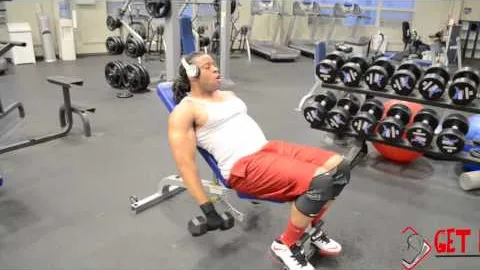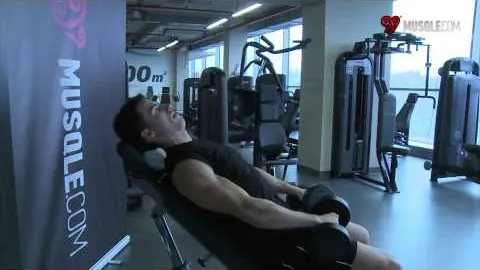




Strength training is an essential component of any well-rounded fitness routine. It helps build muscle mass, increase bone density, and improve overall strength and stability. One highly effective exercise for targeting the shoulders and upper body is the Front Incline Dumbbell Raise. This exercise engages the anterior deltoids, helping to sculpt and strengthen the front of the shoulders, while also engaging other muscles such as the biceps and upper chest.
The Front Incline Dumbbell Raise is a variation of the traditional shoulder raise exercise. It is performed on an incline bench with dumbbells, targeting the front deltoids. The incline bench allows for a greater range of motion, providing a more challenging and effective workout for the shoulders. (Keywords: Front Incline Dumbbell Raise, incline bench, dumbbells, front deltoids)
Increased Shoulder Strength: The Front Incline Dumbbell Raise specifically targets the front deltoids, helping to increase their strength and size. This exercise can help improve overall shoulder stability, allowing for better performance in other upper body exercises.
Enhanced Shoulder Definition: Regularly incorporating the Front Incline Dumbbell Raise into your workout routine can lead to more defined and sculpted shoulders. This exercise helps to isolate the front deltoids, contributing to a balanced and aesthetic upper body appearance.
Improved Posture: Strong front deltoids help support good posture by pulling the shoulders back and opening the chest. By strengthening the front deltoids with the Front Incline Dumbbell Raise, you can improve your overall posture and reduce the risk of developing rounded shoulders.
Complementary Exercise: The Front Incline Dumbbell Raise can be combined with other shoulder exercises, such as lateral raises and overhead presses, to create a well-rounded shoulder workout. This exercise targets the front deltoids, while other exercises focus on different areas of the shoulder muscles.
Follow these step-by-step instructions to properly execute the Front Incline Dumbbell Raise exercise:
Find an incline bench set at approximately a 45-degree angle.
Sit on the bench with your back against the pad, feet flat on the floor, and a dumbbell in each hand.
Hold the dumbbells palms facing down, resting on your thighs.
Begin the exercise by raising the dumbbells until they are in line with your shoulders, keeping your elbows slightly bent.
Avoid swinging or using momentum to lift the dumbbells. Focus on a controlled and smooth movement.
Pause briefly at the top of the movement, squeezing your front deltoids.
Slowly lower the dumbbells back to the starting position, maintaining control throughout the descent.
Repeat the desired number of repetitions or follow the prescribed sets and reps for your workout routine.
To maximize the effectiveness of the Front Incline Dumbbell Raise and reduce the risk of injury, keep the following tips and safety considerations in mind:
Start with lighter weights: It is crucial to begin with a weight that allows you to maintain proper form and control throughout the exercise. Gradually increase the weight as you become more comfortable and confident with the movement.
Engage your core: To stabilize your body during the exercise, engage your core muscles by pulling your belly button towards your spine. This will help protect your lower back and maintain proper alignment.
Avoid excessive shoulder elevation: When lifting the dumbbells, aim for shoulder height and avoid elevating them beyond that point. Overlifting may strain the shoulder joints and increase the risk of injury.
Breathe correctly: Remember to inhale as you lower the dumbbells and exhale as you lift them. Proper breathing helps maintain stability and focus during the exercise.
Consult a professional: If you are new to strength training or have any pre-existing shoulder conditions, consider seeking guidance from a certified personal trainer or fitness professional. They can assess your fitness level, teach you proper form, and provide modifications if necessary.
The Front Incline Dumbbell Raise can be incorporated into your existing shoulder or upper body workout routine. Here are a few ways to include this exercise:
Stand-alone exercise: Perform the Front Incline Dumbbell Raise as a standalone exercise, focusing solely on the front deltoids. Aim for 3-4 sets of 8-12 repetitions, resting for 60 seconds between sets.
Superset with lateral raises: Pair the Front Incline Dumbbell Raise with lateral raises to target both the front and side deltoids. Alternate between the two exercises, completing 3-4 sets of each exercise with 8-12 repetitions.
Tri-set with overhead presses: Combine the Front Incline Dumbbell Raise, lateral raises, and overhead presses into a tri-set. Perform 3 sets of each exercise for 8-12 repetitions, resting for 60 seconds between each exercise.
The Front Incline Dumbbell Raise is a highly effective exercise for targeting the front deltoids and building upper body strength. Incorporating this exercise into your routine can lead to increased shoulder strength, enhanced definition, improved posture, and better overall upper body stability. Remember to use proper form, start with lighter weights, and consult a professional if needed. As with any exercise, consistency is key to achieving optimal results. So, grab those dumbbells, hop on an incline bench, and start reaping the benefits of the Front Incline Dumbbell Raise!
If you're looking for a gym, fitness club or yoga studio, you've come to the right place.
You can find information about gyms in your area. Browse catalog of gyms and find gyms with classes which are you looking for.
On gym page you can find simple information like address, phone or website. You can find list of available classes. You can check availability of personal training or small group classes. On place page you can also see information about open hours.
You can find gyms near you with amenities, courts, studios and equipments.
Use our map to find gym at your city or district.
In Gym Navigator you can find list of exercises with movies for many body parts.
You can browse exercises catalog and find exercises the best of you.
You can also find exercises grouped into workout plans, which you can use to improve you body. Each routine show you exercises one by one and give you possibility to count you progress and count down rest time.